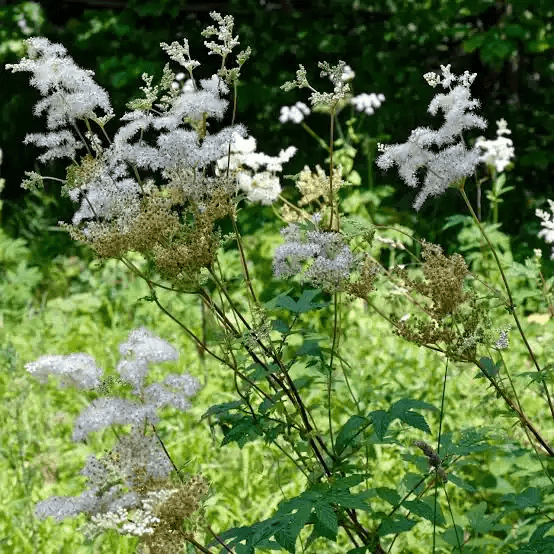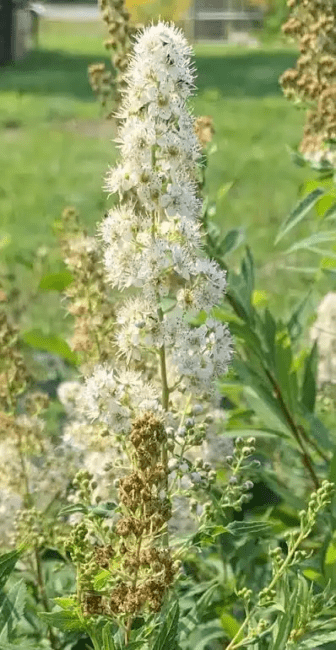Meadowsweet, scientifically known as Filipendula ulmaria, is a perennial herb native to Europe and Western Asia. Also known by other common names such as queen of the meadow, meadow-wort, and bridewort, this plant belongs to the Rosaceae family. Meadowsweet is well-regarded for its ornamental qualities, pleasant fragrance, and historical uses in traditional medicine.
Key features of Meadowsweet include its tall stems, divided and toothed leaves, and clusters of small, creamy-white flowers with a sweet and almond-like fragrance. The flowers bloom in mid to late summer, and their nectar-rich quality attracts bees and butterflies, making Meadowsweet a valuable plant for pollinators.
Historically, Meadowsweet has been recognized for its medicinal properties. In traditional herbal medicine, various parts of the plant, including the flowers and leaves, were used to make infusions and extracts.
Meadowsweet was valued for its potential to alleviate pain and fever. The plant contains salicylates, compounds related to aspirin, and has been used as a natural source of pain relief.
However, it’s important to note that individuals with salicylate sensitivity or those taking certain medications should exercise caution.
Meadowsweet’s historical significance goes beyond its medicinal uses. It is said to have been a favorite herb of Queen Elizabeth I and was often used to flavor mead, a fermented honey beverage, giving rise to its common name.
In landscaping, Meadowsweet is appreciated for its elegant appearance and ability to thrive in damp or wet conditions. It is often used in perennial borders, cottage gardens, and naturalistic landscapes, especially in areas with consistently moist soils.
Cultivating Meadowsweet generally requires partial to full sunlight and well-drained to moist soil. The plant is adaptable and can tolerate a range of soil types, but it particularly excels in damp conditions. Regular watering is beneficial, especially during dry periods.
Filipendula ulmaria, or Meadowsweet, is a charming and versatile herb with a rich history of both medicinal and culinary uses. Its fragrant flowers, adaptability to various growing conditions, and ecological value for pollinators make it a delightful addition to gardens and landscapes.
However, individuals considering the medicinal use of Meadowsweet should exercise caution and consult with healthcare professionals, particularly if they have known sensitivities or are taking medications.
The Botanical Description of Meadowsweet
1. Overview: Meadowsweet, scientifically known as Filipendula ulmaria, is an elegant and aromatic perennial herb that belongs to the rose family, Rosaceae. Renowned for its beauty and medicinal properties, meadowsweet is a staple in traditional herbalism.
2. Height and Form: Typically reaching heights of 2 to 4 feet, meadowsweet boasts a slender, erect stem adorned with lush green, serrated leaves. The plant’s overall form is characterized by a graceful and airy appearance, accentuated by clusters of delicate flowers.
3. Leaves and Leaflets: The leaves of meadowsweet are pinnate, consisting of multiple lance-shaped leaflets arranged alternately along the stem. The vibrant green foliage emits a sweet almond fragrance when crushed, adding to the plant’s allure.
4. Flowers and Inflorescence: Meadowsweet produces clusters of small, creamy-white flowers with a distinct fragrance reminiscent of honey and almonds. The inflorescence forms a corymb, a flat-topped cluster, creating a visually pleasing display.
5. Root System: The root system of meadowsweet is fibrous and relatively shallow, spreading out horizontally. While the roots play a role in the plant’s anchorage, the aerial parts, especially the flowers and leaves, are the primary focus for herbal use.
The Geographic Distribution of Meadowsweet
1. Native Regions: Meadowsweet is native to various regions of Europe and western Asia, where it thrives in damp meadows, stream banks, and other moist habitats. It has also been naturalized in North America and other parts of the world.
2. Preferred Habitats: Meadowsweet exhibits a preference for damp or wet environments, often found along riverbanks, in marshy areas, and near water sources. This affinity for moisture contributes to its prolific growth in specific ecological niches.
3. Global Presence: Due to its adaptability and ornamental value, meadowsweet has been cultivated and introduced to gardens and landscapes worldwide. Its ability to thrive in different climates has made it a beloved addition to diverse flora.
4. Cultivation in Gardens: Gardeners appreciate meadowsweet for its aesthetic qualities, including the fragrant flowers and lush foliage. It is often cultivated as an ornamental plant, contributing to the beauty of garden landscapes.
The Chemical Composition of Meadowsweet
1. Salicylates: Meadowsweet is renowned for its salicylate content, compounds similar to those found in aspirin. These natural salicylates contribute to the plant’s analgesic and anti-inflammatory properties.
2. Flavonoids: The presence of flavonoids in meadowsweet contributes to its antioxidant activity. These compounds play a role in neutralizing free radicals, protecting cells from oxidative stress.
3. Essential Oils: Meadowsweet contains essential oils that contribute to its distinctive fragrance. These oils may also have therapeutic properties, adding to the overall medicinal profile of the plant.
4. Tannins: Tannins found in meadowsweet contribute to its astringent properties. This aspect makes it valuable in traditional medicine for addressing issues related to the gastrointestinal tract.
5. Coumarins: Meadowsweet contains coumarins, which may have anticoagulant and blood-thinning effects. It’s essential for individuals on anticoagulant medications to exercise caution when using meadowsweet.
6. Phenolic Compounds: Various phenolic compounds are present in meadowsweet, contributing to its overall medicinal potential. These compounds may have anti-inflammatory and immune-modulating effects.
7. Mucilage: Meadowsweet contains mucilage, a gel-like substance that has soothing properties. This aspect makes it valuable in addressing respiratory and digestive issues.
8. Quercetin: Quercetin, a flavonoid present in meadowsweet, adds to its antioxidant properties. It is known for its ability to combat inflammation and support cardiovascular health.
9. Ascorbic Acid (Vitamin C): Meadowsweet contains ascorbic acid, also known as vitamin C, which contributes to its immune-boosting properties. Vitamin C is crucial for overall health and well-being.
10. Polyphenols: The presence of polyphenols in meadowsweet contributes to its overall health-promoting effects. Polyphenols are known for their antioxidant and anti-inflammatory properties.
Read Also: 17 Medicinal Health Benefits Of Turkey Corn (Disporum hookeri)
The Medicinal Health Benefits Of Meadowsweet (Filipendula ulmaria)

1. Pain Relief: Meadowsweet is renowned for its natural analgesic properties. The presence of salicylates, akin to those found in aspirin, provides relief from various types of pain, including headaches, muscle aches, and joint discomfort.
2. Anti-Inflammatory Effects: The anti-inflammatory properties of meadowsweet contribute to its effectiveness in reducing inflammation in the body. This makes it valuable for individuals dealing with conditions such as arthritis and inflammatory disorders.
3. Digestive Support: Meadowsweet has a soothing effect on the digestive system. It helps alleviate indigestion, heartburn, and gastric discomfort. The plant’s tannins and mucilage content contribute to its gastroprotective effects.
4. Respiratory Health: For respiratory issues, meadowsweet can be beneficial. Its anti-inflammatory and expectorant properties make it a potential remedy for conditions like coughs, bronchitis, and other respiratory ailments.
5. Fever Reduction: Traditionally used to lower fevers, meadowsweet’s salicylate content contributes to its antipyretic effects. It helps regulate body temperature and provides relief during febrile conditions.
6. Urinary Tract Health: Meadowsweet has diuretic properties that support urinary tract health. It aids in flushing out toxins and may be used to address mild urinary issues.
7. Immune System Boost: The presence of vitamin C and other immune-boosting compounds in meadowsweet contributes to its ability to enhance overall immune function, supporting the body’s defense mechanisms.
8. Relaxant and Stress Reduction: Meadowsweet’s relaxing properties can help reduce stress and tension. It is often used to promote relaxation and soothe the nervous system.
9. Skin Conditions: Applied topically, meadowsweet may aid in the management of certain skin conditions. Its anti-inflammatory and astringent qualities make it useful for soothing irritated skin.
10. Menstrual Support: For women’s health, meadowsweet may offer relief from menstrual cramps and discomfort. Its analgesic and anti-inflammatory effects contribute to its potential in managing menstrual symptoms.
The Methods of Usage to Achieve the Provided Health Benefits Of Meadowsweet (Filipendula ulmaria)
1. Herbal Tea Infusion: Brewing meadowsweet as a herbal tea is a common and accessible method. This allows for the extraction of its beneficial compounds and is an enjoyable way to experience its effects.
2. Tinctures and Extracts: Liquid extracts, such as tinctures, provide a concentrated form of meadowsweet. These extracts offer a convenient and measured way to incorporate the plant’s benefits into daily routines.
3. Capsules or Tablets: Meadowsweet supplements in capsule or tablet form provide a controlled dosage for those who prefer a more straightforward method of consumption.
4. Poultices and Compresses: Creating poultices or compresses with meadowsweet for topical application can be effective in addressing localized pain, inflammation, or skin conditions.
5. Steam Inhalation: Inhaling steam infused with meadowsweet can provide respiratory benefits. This method is suitable for addressing issues like coughs and bronchitis.
6. Bath Additive: Adding meadowsweet to a bath can offer a soothing and relaxing experience. This method is beneficial for overall well-being and may have skin-soothing effects.
7. Syrups and Elixirs: Meadowsweet syrups, often sweetened for palatability, provide another option for easy consumption. This method is suitable for those who prefer a more pleasant taste.
8. Oil Infusions: Infusing meadowsweet in oil creates an oil extract that can be used topically for skin-related issues. This method is particularly useful for addressing skin conditions.
9. Culinary Uses: In some culinary preparations, meadowsweet can be incorporated. However, it’s important to note that the concentration of beneficial compounds may vary in culinary use.
10. Smoking Blends: In some traditional practices, meadowsweet has been included in smoking blends for its potential respiratory benefits. However, caution is advised due to the potential health risks associated with smoking.
The Side Effects Of Using Meadowsweet Medicinal Plant
1. Allergic Reactions: Individuals with known allergies to plants in the Rosaceae family, such as strawberries and almonds, may experience allergic reactions to meadowsweet. A patch test is advisable before widespread use.
2. Gastrointestinal Discomfort: Excessive consumption of meadowsweet may lead to gastrointestinal discomfort in some individuals. It’s important to adhere to recommended dosages to avoid such effects.
3. Interaction with Medications: Meadowsweet, containing salicylates, may interact with certain medications, especially blood-thinning medications. Individuals on medication should consult healthcare providers before using meadowsweet.
4. Not Recommended During Pregnancy: Pregnant individuals should exercise caution, and professional advice is recommended before using meadowsweet due to its potential effects on uterine activity.
5. Avoid During Breastfeeding: Breastfeeding individuals should avoid meadowsweet due to limited safety data regarding its effects on nursing infants.
6. Not for Prolonged Use: Using meadowsweet for extended periods may lead to potential side effects. It’s advisable to use it intermittently and under professional guidance.
7. Salicylate Sensitivity: Individuals with sensitivity to salicylates should use meadowsweet cautiously, as it contains natural compounds similar to aspirin.
8. Potential Blood-Thinning Effects: The blood-thinning effects of meadowsweet may pose risks for individuals with bleeding disorders or those scheduled for surgery. Professional consultation is crucial in such cases.
9. Not for Children Under Two: Due to the presence of salicylates, meadowsweet is not recommended for children under two years old. Professional advice is essential for pediatric use.
10. Quality of Source: Ensuring the quality and purity of meadowsweet products is crucial to avoid contaminants. Sourcing from reputable suppliers contributes to the overall safety of use.
Read Also: How Guava Fruits and Leaves Improve Female Fertility
The Scientific Research and Studies of Meadowsweet (Filipendula ulmaria)

1. Anti-Inflammatory Properties: Scientific research has delved into meadowsweet’s anti-inflammatory properties, specifically its ability to inhibit pro-inflammatory markers. Studies suggest that compounds like salicylates contribute to its effectiveness in reducing inflammation.
2. Analgesic Effects: Research on meadowsweet has explored its analgesic effects, revealing potential mechanisms for pain relief. The salicylates present in the plant may act as natural pain relievers, making it a subject of interest in pain management studies.
3. Gastroprotective Potential: Studies have investigated meadowsweet’s gastroprotective potential. The plant’s tannins and mucilage may play a role in protecting the gastrointestinal lining, offering insights into its traditional use for digestive support.
4. Antioxidant Activity: Scientific studies have assessed meadowsweet’s antioxidant activity, attributed to its flavonoids and other polyphenolic compounds. These antioxidants contribute to neutralizing free radicals, showcasing potential health benefits.
5. Respiratory Health Applications: Research has explored meadowsweet’s applications for respiratory health. Its anti-inflammatory and expectorant properties make it a subject of interest in studies focused on respiratory conditions such as bronchitis.
6. Antimicrobial Properties: Scientific investigations into meadowsweet have highlighted its antimicrobial properties. Certain compounds in the plant may exhibit activity against microbes, presenting possibilities for future developments in natural antimicrobial agents.
7. Cardiovascular Effects: Studies have explored meadowsweet’s potential cardiovascular effects, particularly its impact on blood circulation. The presence of salicylates may contribute to mild blood-thinning effects, warranting attention in cardiovascular research.
8. Neuroprotective Potential: Research suggests that meadowsweet may have neuroprotective potential. Compounds in the plant could exhibit protective effects on nerve cells, opening avenues for further studies in neurology and brain health.
9. Anti-Cancer Properties: Scientific investigations have delved into meadowsweet’s potential anti-cancer properties. Some studies suggest that certain compounds in the plant may exhibit anti-carcinogenic effects, though more research is needed in this area.
10. Immunomodulatory Effects: Research has explored meadowsweet’s immunomodulatory effects. Compounds like vitamin C and polyphenols contribute to its ability to modulate immune responses, showcasing its potential in supporting overall immune function.
The Safety Precautions and Recommendations In Using Meadowsweet (Filipendula ulmaria) Medicinal Plant
1. Allergies and Sensitivities: Individuals with known allergies to aspirin or plants in the Rosaceae family should exercise caution. A patch test is advisable before widespread use to check for potential allergic reactions.
2. Moderation in Consumption: While meadowsweet is generally safe when used appropriately, moderation is key. Excessive consumption may lead to gastrointestinal discomfort, and recommended dosages should be followed.
3. Interaction with Medications: Meadowsweet contains salicylates, similar to aspirin, and may interact with certain medications, especially blood-thinning drugs. Consultation with healthcare providers is crucial for individuals on medication.
4. Not Recommended During Pregnancy: Pregnant individuals should avoid using meadowsweet without professional guidance. Limited safety data is available, and potential effects on uterine activity warrant caution.
5. Caution During Breastfeeding: Breastfeeding individuals should refrain from using meadowsweet due to limited safety data regarding its effects on nursing infants. Professional advice is essential for lactating individuals.
6. Not for Prolonged Use: Extended use of meadowsweet may lead to potential side effects. It’s advisable to use it intermittently and under professional guidance, especially for prolonged medicinal applications.
7. Salicylate Sensitivity: Individuals with sensitivity to salicylates should use meadowsweet cautiously. Monitoring for any adverse reactions is essential, and professional advice is recommended.
8. Not for Children Under Two: Meadowsweet is not recommended for children under two years old due to its salicylate content. Pediatric use should be guided by healthcare professionals.
9. Quality of Source: Ensuring the quality and purity of meadowsweet products is crucial. Sourcing from reputable suppliers minimizes the risk of contaminants and ensures the safety of use.
10. Individual Health Considerations: Individuals with pre-existing health conditions, especially liver disorders or bleeding disorders, should consult healthcare providers before using meadowsweet. Professional guidance is essential for personalized safety considerations.
FAQs About Meadowsweet (Filipendula ulmaria) Medicinal Plant
1. Is Meadowsweet Safe for Long-Term Use?
While meadowsweet is generally safe for short-term use, prolonged use may lead to potential side effects. It’s advisable to use it intermittently and under professional guidance.
2. Can Meadowsweet Be Used During Pregnancy?
Pregnant individuals should avoid using meadowsweet without professional guidance. Limited safety data is available, and potential effects on uterine activity warrant caution.
3. Are There Any Known Drug Interactions with Meadowsweet?
Meadowsweet contains salicylates and may interact with certain medications, especially blood-thinning drugs. Consultation with healthcare providers is crucial for individuals on medication.
4. Can Meadowsweet Cause Allergic Reactions?
Individuals with known allergies to aspirin or plants in the Rosaceae family should use meadowsweet cautiously. A patch test is advisable before widespread use.
5. Is Meadowsweet Safe for Children?
Meadowsweet is not recommended for children under two years old due to its salicylate content. Pediatric use should be guided by healthcare professionals.
6. How Quickly Can One Expect to See Results from Meadowsweet Use?
The timeline for experiencing results from meadowsweet use may vary depending on the individual and the health condition being addressed.
Read Also: Banana Tree Care: What You Need to Know

